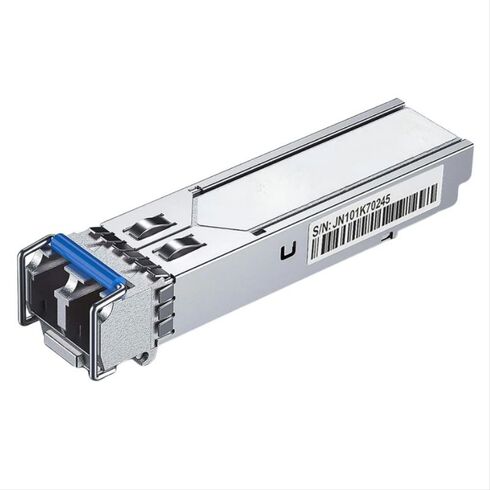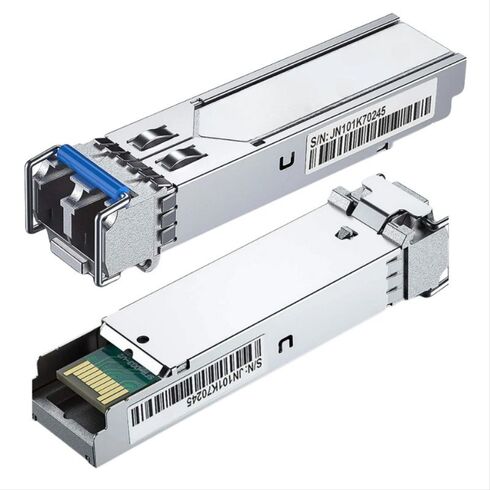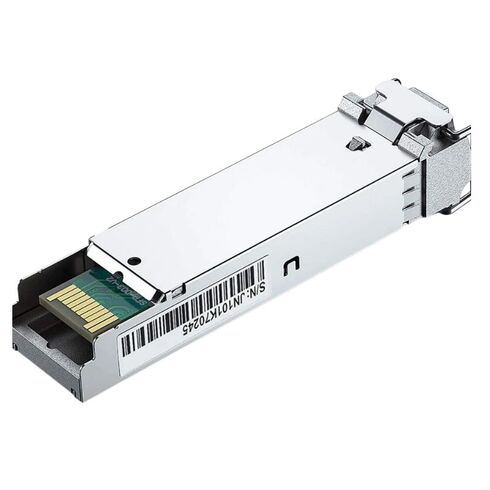GLC-BX40-U-I Cisco GBIC SFP SMF Transceiver Module
- — Free Ground Shipping
- — Min. 6-month Replacement Warranty
- — Genuine/Authentic Products
- — Easy Return and Exchange
- — Different Payment Methods
- — Best Price
- — We Guarantee Price Matching
- — Tax-Exempt Facilities
- — 24/7 Live Chat, Phone Support
- — Visa, MasterCard, Discover, and Amex
- — JCB, Diners Club, UnionPay
- — PayPal, ACH/Bank Transfer (11% Off)
- — Apple Pay, Amazon Pay, Google Pay
- — Buy Now, Pay Later - Affirm, Afterpay
- — GOV/EDU/Institutions PO's Accepted
- — Invoices
- — Deliver Anywhere
- — Express Delivery in the USA and Worldwide
- — Ship to -APO -FPO
- — For USA - Free Ground Shipping
- — Worldwide - from $30
Same product also available in:
| SKU/MPN | Warranty | Price | Condition | You save |
|---|---|---|---|---|
| GLC-BX40-U-I | 1 Year Warranty | $1,150.00 | Factory-Sealed New Retail in Original Box (FSB) | You save: $402.50 (26%) |
| GLC-BX40-U-I | 1 Year Warranty | $793.00 | Excellent Refurbished | You save: $277.55 (26%) |
Product Overview
Key Specifications
- Device Type: SFP (Mini-GBIC) Transceiver Module
- Form Factor: Plug-in Module
Networking Capabilities
Connectivity Technology
- Wired Connectivity: Designed for reliable wired connections
Cabling and Protocols
- Cabling Type: 1000BASE-BX40-U
- Data Link Protocol: Gigabit Ethernet (GiGE)
- Optical Wavelength: 1310 nm (transmit) / 1550 nm (receive)
- Maximum Transfer Distance: Up to 24.9 miles
Additional Features
- Digital Optical Monitoring: Supports Digital Optical Monitoring (DOM) for enhanced performance tracking
- Standards Compliance: Meets IEEE 802.3ah specifications
Expansion and Connectivity Options
Interfaces
- Ethernet Interface: 1 x Ethernet 1000BASE-BX40-D - LC/PC Single-mode
Fiber Type: Single Mode
The Benefits of Single Mode Fiber
When it comes to long distance data transmission, single mode fiber is the go-to choice for professionals in the networking industry. This fiber type offers several key benefits that make it essential for high-performance networks.
Higher Bandwidth
Single mode fiber has a smaller core size compared to multimode fiber, allowing for a higher bandwidth capacity. This means that it can carry a larger volume of data over longer distances without signal degradation. With the increasing demand for higher data rates, single mode fiber is crucial for supporting bandwidth-intensive applications and services.
Greater Transmission Distance
One of the most significant advantages of single mode fiber is its ability to transmit data over long distances. With its narrower core, it can maintain signal integrity over much greater lengths compared to multimode fiber. This makes it ideal for connecting network devices that are located far apart, such as across campuses or between buildings.
Lower Signal Loss
Single mode fiber experiences significantly lower signal loss compared to multimode fiber. This means that the data transmitted through single mode fiber can travel farther without requiring expensive amplification equipment. The reduced signal loss also contributes to better reliability and overall network performance.
Immunity to Modal Dispersion
Modal dispersion is a phenomenon where different modes of light travel at different speeds within the fiber, causing signal distortion. Single mode fiber eliminates this issue by supporting only one mode of light propagation. This ensures that the transmitted data arrives at its destination with minimal delay and distortion, resulting in improved network reliability.
The Importance of Single Mode Fiber for Users
For users who require reliable and efficient long-distance data transmission, the choice of fiber type is crucial. Single mode fiber provides the necessary features to meet these requirements and offers several advantages over multimode fiber.
Enterprise Networks
In enterprise networks, where data needs to be transmitted over extended distances, single mode fiber is essential. It allows organizations to connect their various network devices, data centers, and remote offices seamlessly. With its ability to support high bandwidth and long transmission distances, single mode fiber ensures smooth and reliable communication across the entire network infrastructure.
Telecommunication Systems
In the telecommunications industry, single mode fiber is the backbone for transmitting vast amounts of data over long distances. It enables telecom service providers to deliver high-speed internet, voice, and video services to their customers. With the increasing demand for bandwidth-intensive applications like video streaming and cloud services, single mode fiber plays a vital role in meeting these requirements.
Data Centers
Data centers require efficient connectivity solutions to handle the massive amounts of data they process daily. Single mode fiber allows for seamless connectivity between different data center locations, enabling efficient data replication and backup processes. Its ability to support high data rates and long transmission distances ensures that data centers can operate with maximum reliability and performance.
Compatibility: Cisco Devices
Cisco Devices and GLC-BX40-U-I Compatibility
The Cisco GLC-BX40-U-I GBIC SFP transceiver module is designed specifically for compatibility with Cisco devices. This compatibility ensures seamless integration into Cisco networking environments, providing users with a reliable and efficient solution for their networking needs.
Plug-and-Play Integration
The GLC-BX40-U-I transceiver module is engineered to be plug-and-play compatible with Cisco devices. This means that users can simply insert the module into their Cisco equipment without any additional configuration or setup. The seamless integration allows for quick and hassle-free deployment, saving time and effort for network administrators.
Cisco Quality Assurance
By choosing a Cisco-compatible transceiver module like the GLC-BX40-U-I, users can benefit from Cisco's rigorous quality assurance processes. Cisco thoroughly tests and validates their products to ensure they meet the highest standards of performance, reliability, and compatibility. This gives users peace of mind knowing that their network infrastructure is built with trusted and proven components.
Interoperability with Cisco Features
The GLC-BX40-U-I transceiver module is designed to fully leverage the features and capabilities of Cisco devices. It seamlessly integrates with Cisco's advanced networking technologies, enabling users to take advantage of features such as quality of service (QoS), security protocols, and advanced management functionalities.
The Importance of Cisco Compatibility for Users
Choosing a transceiver module that is compatible with Cisco devices offers several important benefits for users in Cisco networking environments.
Seamless Integration
By selecting a Cisco-compatible transceiver module like the GLC-BX40-U-I, users can ensure a smooth integration process. The module is specifically designed to work seamlessly with Cisco devices, eliminating any compatibility issues or configuration complexities. This allows for faster deployment and reduces the risk of network downtime during implementation.
Enhanced Performance and Reliability
Cisco-compatible transceiver modules undergo rigorous testing to meet the high standards set by Cisco. This ensures that users can expect optimal performance and reliability from their network infrastructure. By using compatible modules, users can minimize the risk of compatibility-related issues that may impact network performance or cause system failures.
By utilizing Cisco-compatible transceiver modules, users can take full advantage of the advanced features and capabilities offered by Cisco devices. These features enable enhanced network management, security, and performance optimization. The compatibility ensures that users can leverage the full potential of their Cisco networking infrastructure.
Data Rate: 40 Gbps
The Benefits of 40 Gbps Data Rate
With the ever-increasing demand for higher data rates, the GLC-BX40-U-I transceiver module provides an impressive data rate of 40 Gbps. This high-speed capability offers several benefits for users in terms of network performance and scalability.
Increased Bandwidth Capacity
A data rate of 40 Gbps allows for a substantial increase in bandwidth capacity compared to lower-speed alternatives. This is especially important for networks that handle large volumes of data, such as data centers or enterprise networks with high user demands. The increased bandwidth capacity ensures smooth and efficient data transmission, even under heavy network traffic conditions.
Support for Bandwidth-Intensive Applications
Bandwidth-intensive applications, such as video streaming, cloud services, and big data analytics, require high-speed data transmission to operate effectively. The 40 Gbps data rate provided by the GLC-BX40-U-I transceiver module ensures that these applications can run seamlessly without experiencing bottlenecks or performance degradation. Users can rely on the module's high-speed capabilities to support their most demanding applications.
Future-Proof Network Infrastructure
Investing in a transceiver module with a 40 Gbps data rate helps future-proof the network infrastructure. As technology advances and the demand for higher data rates continues to grow, having a module that can support these higher speeds ensures long-term compatibility and scalability. Users can avoid the need for frequent upgrades or replacements, saving both time and money.
The Importance of 40 Gbps Data Rate for Users
For users who require high-performance networking solutions, the data rate is a critical factor to consider. The GLC-BX40-U-I transceiver module's 40 Gbps data rate offers several important benefits for users in various networking environments.
Enterprise Networks
In enterprise networks, where large amounts of data need to be transmitted between different locations, a high data rate is essential. The 40 Gbps data rate provided by the GLC-BX40-U-I module ensures that enterprise networks can handle high user demands and support bandwidth-intensive applications effectively. It enables organizations to maintain a fast and reliable network infrastructure that can keep up with their evolving needs.
Data Centers
Data centers require high-speed connectivity solutions to accommodate the massive volumes of data they process daily. The 40 Gbps data rate offered by the GLC-BX40-U-I transceiver module allows data centers to handle the increasing demands of virtualization, cloud computing, and big data applications. It ensures that data replication, backup processes, and data transfers within the data center occur efficiently and without any performance bottlenecks.
Service Providers
In the telecommunications industry or any service provider environment, a high data rate is crucial to delivering reliable and high-quality services to customers. The 40 Gbps data rate provided by the GLC-BX40-U-I module allows service providers to meet the growing demand for bandwidth-intensive applications like video streaming or online gaming. It ensures that customers receive a fast and seamless experience without any disruptions or delays.
Wavelength: 1310 nm
The Benefits of 1310 nm Wavelength
The GLC-BX40-U-I transceiver module operates at a wavelength of 1310 nm, which offers several benefits for users in terms of signal quality, compatibility, and network performance.
Signal Quality and Stability
1310 nm is a widely used wavelength in optical communication systems due to its excellent signal quality and stability. It provides a good balance between signal attenuation and dispersion, resulting in reliable data transmission over long distances. The 1310 nm wavelength ensures that data arrives at its destination with minimal degradation or signal loss.
Compatibility with Existing Infrastructure
The 1310 nm wavelength is compatible with a wide range of existing optical infrastructure. This compatibility makes it easier for users to integrate the GLC-BX40-U-I module into their existing network setups without the need for extensive modifications or replacements. It allows for a cost-effective and efficient upgrade path for users who require higher data rates or longer transmission distances.
Interference-Free Operation
1310 nm is located within the "first window" of the optical spectrum, which is relatively free from interference caused by other light sources. This ensures that the transmitted data is not affected by external noise or crosstalk, resulting in a more reliable and stable network connection. Users can trust that their data will be transmitted without any interference-related issues that could impact network performance.
The Importance of 1310 nm Wavelength for Users
For users who require optimal signal quality, compatibility, and reliability in their network infrastructure, the choice of wavelength is crucial. The 1310 nm wavelength used by the GLC-BX40-U-I transceiver module offers several important benefits in various networking environments.
Long-Distance Communication
The 1310 nm wavelength is well-suited for long-distance communication due to its excellent signal quality and stability. It enables users to establish reliable connections over extended distances without experiencing significant signal degradation or loss. This is particularly important for applications that require data transmission between geographically dispersed locations, such as connecting remote offices or interconnecting data centers.
Migration Path for Existing Networks
For users who already have optical infrastructure operating at the 1310 nm wavelength, the GLC-BX40-U-I transceiver module offers a seamless migration path. The compatibility with existing infrastructure allows users to upgrade their network capabilities without the need for extensive changes or replacements. This ensures a smooth transition to higher data rates or longer transmission distances while minimizing disruption and cost.
Flexibility and Scalability
The 1310 nm wavelength provides users with flexibility and scalability in building their network infrastructure. It allows for easy integration with a wide range of optical devices and networking equipment, ensuring compatibility and interoperability. Users can expand their network as needed, knowing that the 1310 nm wavelength provides a reliable and widely supported solution.
Distance: Up to 40 km
The Benefits of Up to 40 km Distance
The GLC-BX40-U-I transceiver module supports transmission distances of up to 40 km, providing users with several benefits in terms of network connectivity, flexibility, and cost-effectiveness.
Extended Network Reach
The ability to transmit data up to 40 km allows users to connect network devices that are located far apart. This is particularly useful for organizations with geographically dispersed locations or those requiring long-distance connections between data centers. The extended network reach ensures that data can be transmitted seamlessly across wide areas, enabling efficient communication and collaboration.
Cost-Effective Solution
The GLC-BX40-U-I module's support for up to 40 km transmission distances offers a cost-effective solution for long-distance connectivity. It eliminates the need for expensive additional equipment, such as signal boosters or repeaters, which would be required for shorter-range alternatives. Users can save on infrastructure costs while still achieving reliable and high-performance connections over extended distances.
Flexibility in Network Design
The capability to transmit data up to 40 km provides users with greater flexibility in designing their network infrastructure. It allows for more freedom in choosing the location of network devices and optimizing network topology. Users can establish connections between sites or devices without being constrained by proximity, resulting in a more efficient and adaptable network design.
The Importance of Up to 40 km Distance for Users
For users who require long-distance connectivity and flexibility in their network infrastructure, the ability to transmit data up to 40 km is crucial. The GLC-BX40-U-I transceiver module offers several important benefits in various networking environments.
Wide-Area Networks (WANs)
In wide-area networks, where connections span across vast distances, the GLC-BX40-U-I module's support for up to 40 km transmission is essential. It enables organizations to establish reliable and high-speed connections between remote locations, ensuring seamless communication and data transfer. Whether connecting branch offices or linking data centers, the module provides the necessary reach for efficient WAN connectivity.
Telecommunication Providers
Telecommunication service providers often require long-distance connections to deliver services to their customers. The GLC-BX40-U-I module's support for up to 40 km transmission distances allows providers to extend their network coverage and offer connectivity to remote areas. It ensures that customers in these locations can access high-speed internet, voice, and video services without compromising on performance or reliability.
Infrastructure Expansion
For organizations planning to expand their network infrastructure, the ability to transmit data up to 40 km provides ample room for growth. It allows for future expansion and the addition of new sites or devices without the need for major infrastructure changes. Users can build scalable and flexible network architectures that can accommodate their evolving needs with confidence.











